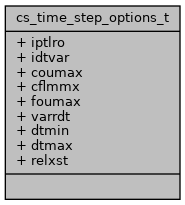|
My Project
programmer's documentation
|
|
My Project
programmer's documentation
|
time step options descriptor More...
#include <cs_time_step.h>

Data Fields | |
| int | iptlro |
| int | idtvar |
| double | coumax |
| double | cflmmx |
| double | foumax |
| double | varrdt |
| double | dtmin |
| double | dtmax |
| double | relxst |
time step options descriptor
Members of this time step options descriptor are publicly accessible, to allow for concise syntax.
| cflmmx |
Max. Courant number for the continuity equation in compressible model.
| coumax |
Maximum Courant number (when idtvar is different from 0).
| dtmax |
Upper limit for the calculated time step when idtvar is different from 0. Take dtmax = max (ld/ud, sqrt(lt/(gdelta rho/rho)), ...).
| dtmin |
Lower limit for the calculated time step when idtvar is different from 0. Take dtmin = min (ld/ud, sqrt(lt/(gdelta rho/rho)), ...).
| foumax |
Maximum Fourier number (when idtvar is different from 0).
| idtvar |
Option for a variable time step
| iptlro |
Clip the time step with respect to the buoyant effects
When density gradients and gravity are present, a local thermal time step can be calculated, based on the Brunt-Vaisala frequency. In numerical simulations, it is usually wise for the time step to be lower than this limit, otherwise numerical instabilities may appear.
iptlro indicates whether the time step should be limited to the local thermal time step (=1) or not (=0).
When iptlro=1, the log shows the number of cells where the time step has been clipped due to the thermal criterion, as well as the maximum ratio between the time step and the maximum thermal time step. If idtvar=0, since the time step is fixed and cannot be clipped, this ratio can be greater than 1. When idtvar > 0, this ratio will be less than 1, except if the constraint dtmin has prevented the code from reaching a sufficiently low value for dt. Useful when density gradients and gravity are present.
| relxst |
Relaxation coefficient for the steady algorithm. relxst = 1 : no relaxation.
| varrdt |
Maximum allowed relative increase in the calculated time step value between two successive time steps (to ensure stability, any decrease in the time step is immediate and without limit).
Useful when idtvar is different from 0.
 1.8.16
1.8.16